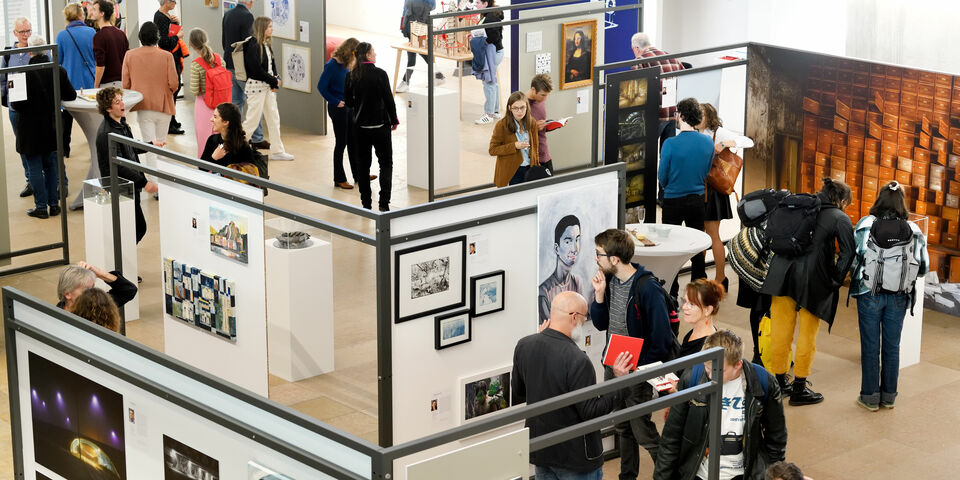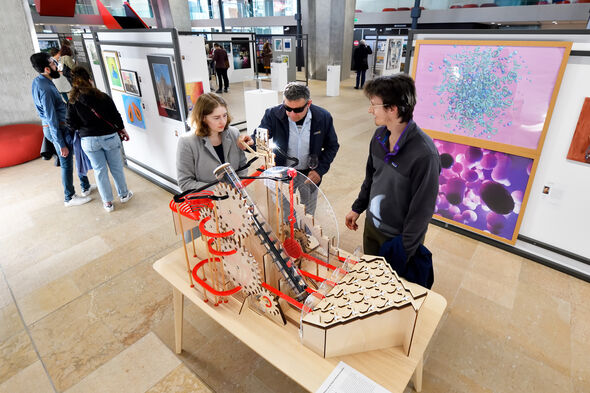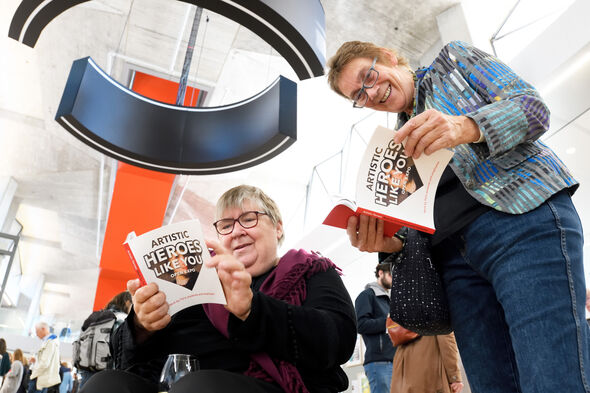Heroic acts in paint, wool and precious metals
From a marble run to poetry: there are many, often unexpected artists within the TU/e community. This much became apparent last Thursday, during the opening of the exhibition ‘Artistic Heroes Like You.’ The artworks created by TU/e students and employees will be on exhibit until October 28 in the hall of the Atlas building.
University secretary Susanne van Weelden immediately responded enthusiastically when she heard about the plan to bring TU/e’s previous lustrum exhibition from 2011 back to life, she says during her speech last Thursday afternoon, “However, I didn’t know at that time that Studium Generale would ask me to submit some of my own work.”
Van Weelden, who decided to quit her photography training four years ago because she wanted to focus on her new job at TU/e, exhibits photographs that she made of brutalist architecture in London. She says that she visited as many exhibitions as possible during the summer break, to catch up on the things she had missed during the lockdowns. And how much inspiration and energy that gave her: “I simply need art.”
The latter statement applies to more participants at this exhibition. Many of them said in the interviews published in the exhibition catalogue that they value the role of art at TU/e: creativity is an essential part of problem solving in research, for example. Lucas Asselbergs, head of Studium Generale, presents Van Weelden and Ingrid Heynderickx, chair of the lustrum committee, with the first two copies of the catalogue.
Fountain pen
The exhibition is extremely varied. The smallest work is not larger than two centimeters, for example, and the largest one measures two meters. There is jewelry, painted stones, a crocheted plaid, poems, sculptures, a fountain pen, scale models, a painted pair of jeans and even a marble run. Most works, however, are two dimensional: photography, paintings, drawings and digital art.
The group of artists is quite diverse as well – Van Weelden links the exhibition to the Diversity Week, which happens to take place this same week. There are no fewer than eighteen nationalities among the contributors to the exhibition, 70 percent of whom are women and 30 percent men.
Iranian is the second-best represented nationality, after Dutch, David Ernst of Studium Generale says. The best represented departments are, unsurprisingly, Industrial Design and Built Environment.
Wheelchair users
Focus on diversity is an important motive for Pia Hendriks (1954), who is now retired but who used to work at Data Management & Library. Since 2013, she has been part of a portrait painting group made up of (former) colleagues who take turns posing for one another.
Hendriks exhibits three painted portraits of people who, like herself, are wheelchair bound. “I see this as a statement: people with a disability also need to be able to recognize themselves in art.”
Not all wheelchair users are the same, she stresses, they have their own lives and personalities like everyone else. This is reflected in her portraits. Hendriks mobilized her network – she is in charge of a Facebook group devoted to making the Netherlands more accessible for the disabled – and immediately received a variety of photographs for her to paint.
Corona frustration
Student Iris Borst, (2000, Industrial Engineering) is standing next to two of her drawings with a radiant expression on her face. “This is my first exhibition. I feel quite anxious: I never told any of my fellow students about my work, and now it’s out in the open.”
Her study choice was between art academy and TU/e. “I chose technology, but I promised myself to continue to develop my artistic side.”
One of the works on exhibition, Don’t Show Me How, was made during the corona lockdown. It is a portrait of a young woman with her hands stretched out in front of her in a repelling gesture. “I let go of everything and expressed all my frustrations on paper, with water color, felt pen and pencil, rough and without taking notice of the correct proportions. That worked out well.”
The title refers to the fact that she is perfectly able as a woman to make her own decisions. “I mostly draw portraits of women. These aren’t really self-portraits, but I often refer to aspects of myself.”
Making mistakes
Terry van den Bunder (1992), PDEng at Mechanical Engineering, submitted a few of his poems as an example and proposed to write a special poem about the hero theme. To his surprise, one of the poems he sent as an example was selected for the exhibition.
“The poem, which was written as a spoken word performance, is about someone who rebels against his Dutch teacher who wants him to write perfectly, whereas the student wants to express himself freely.” In that sense, there is a link between his poem and the hero theme of the lustrum and the exhibition after all, Van den Bunder realizes: “Superheroes aren’t allowed to make mistakes either.”
The exhibition Artistic Heroes Like You can be visited in the hall of the Atlas building until October 28.




Discussion